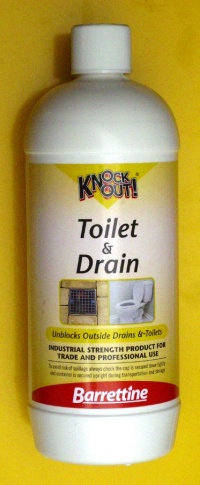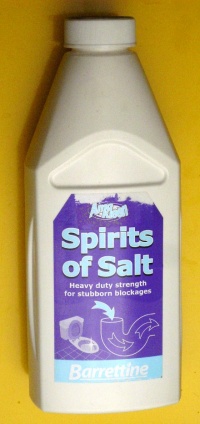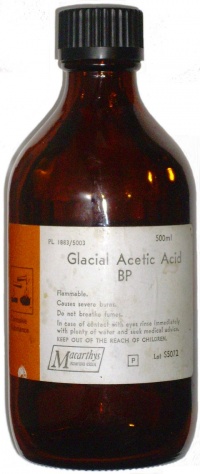Difference between revisions of "Acid"
Jump to navigation
Jump to search
(→Chromic Acid: remove) |
(→Sulphuric Acid: holes) |
||
| Line 48: | Line 48: | ||
* Take proper care to keep sulphuric away from kids, the results can be nasty | * Take proper care to keep sulphuric away from kids, the results can be nasty | ||
* Wipe down [[Battery|batteries]] after filling them with acid | * Wipe down [[Battery|batteries]] after filling them with acid | ||
| − | * Best wear clothing of little value when handling the acid or [[Lead acid battery|lead acid batteries]]. | + | * Best wear clothing of little value when handling the acid or [[Lead acid battery|lead acid batteries]], clothing usually ends up with tiny holes. |
* Don't heat concentrated sulphuric acid, the risks increase excessively | * Don't heat concentrated sulphuric acid, the risks increase excessively | ||
* [http://msds.chem.ox.ac.uk/SU/sulfuric_acid_concentrated.html MSDS] | * [http://msds.chem.ox.ac.uk/SU/sulfuric_acid_concentrated.html MSDS] | ||
Revision as of 02:03, 5 December 2014
Precautions
Most acids used in DIY are high risk chemicals. Several precautions are advisable with many acids. These don't all apply to vinegar & citric acid.
- Due to the potentially high risk involved, labels should be read and advice followed
- When diluting, never add water to acid, always add acid to water, and stir promptly. Diluting is sometimes highly exothermic, and should be done a bit at a time, wearing safety specs and stopping if it gets hot. If done the wrong way (putting water into acid) the result can even progress to explosion sometimes. Exploding boiling acid is not an essential nutrient.
- Never mix concentrated acid with alkali, or acid with concentrated alkali.
- If you mix dilute acid and alkali (to render them safe enough for disposal), do so gradually, stirring, and stop if it gets hot.
- Some acids used in DIY eat through skin rapidly. Wear suitable gloves
- When holding the bottle, do so by the label area, so any unnoticed runs are on the back where you're not holding it. Rinsing the bottle exterior after use is a good precaution with hostile acids.
- Don't mix acid with bleach, the resulting chlorine is toxic enough to kill.
- Don't mix acid with alkalis, excess heat is generated, and boiling spitting acid isn't a great idea.
- Some acids plus metal can generate hydrogen, which is explosive above 4% concentration.
- Suitable gloves & eye protection are sensible for some of the acids. Gloves can be inflated and put under water to check for holes, wise if you're handling the nastier acids.
- Full face visor should be used for the more hostile acids, and is a good thing for other acids.
- In case of skin contact with all but the mild acids, wash for 10 minutes to minimise burning, chemical reaction & contamination. In case of eye contact, wash for at least 10 minutes and seek medical help promptly. Use the correct neutraliser for HF.
- Have a suitable neutraliser available.
- For small amounts this can be baking soda or washing soda
- When handling bulk acids a garden hose is more effective.
- For hydrofluoric acid, specific neutralisers are needed
- Have eyewash equipment available. If you need to use it, time is pretty important.
- When carrying bulk acid or hostile acids, hold them in a sturdy container away from you. This avoids you getting drenched and maybe killed if you drop the container or it breaks.
- Plastic bottles can degrade over time. Keep out of sunlight, and use the older ones first. When buying, plastic containers with weathered looking labels might have been sitting in the sun for years.
- Store powerful acids at floor level to reduce risk of breakage.
Sulphuric Acid
A strong acid, sulphuric acid has many names, including vitriol, glover acid, tower acid, fertiliser acid, chamber acid, battery acid, dipping acid, mattling acid, electrolyte acid.
Uses
- Eats organic materials rapidly. Eats paper etc in seconds.
- Good for unblocking drains where the blockage is organic
- Rapidly eats the paper content in toilet blockages, which caustic soda doesn't.
- Density of 1.84 means it sinks to the bottom of blockages.
- Lead acid batteries use pure sulphuric acid of around 4M or 30%. Less pure drain cleaning acid is not for batteries.
- Very strong desiccant, but attacks most materials people want to dry, and adding water to concentrated sulphuric acid can in some cases result in explosion
- Reaction with paper, sugar etc produces carbon, but demonstrations can catch fire, boil, and spit acid
- Reaction of dilute H2SO4 with hot copper produces copper sulphate, a mould inhibiting antimicrobial.
- Reaction with zinc produces zinc sulphate, a mould inhibiting antimicrobial.
Risks
- 98% sulphuric acid drain unblocker is probably the most dangerous of the acids used in DIY. Put a drop on paper for a demo.
- Dangerous to skin & eyes
- Destroys cement joints in ceramic pipes
- Toxic
- Concentrated sulphuric acid can react violently with water
- Boiling sulphuric acid is highly dangerous. The rate of chemical activity doubles with every 10C temperature rise, and conc. sulphuric boils at 337C.
- In work situations all use of sulphuric acid must be assessed under the COSHH regulations.
- Take proper care to keep sulphuric away from kids, the results can be nasty
- Wipe down batteries after filling them with acid
- Best wear clothing of little value when handling the acid or lead acid batteries, clothing usually ends up with tiny holes.
- Don't heat concentrated sulphuric acid, the risks increase excessively
- MSDS
Purchase
- Upto 98% sulphuric acid is available as drain unblocker.
Hydrochloric Acid
- A strong acid
- Also known as spirits of salt, muriatic acid
Uses
- Eats cement & lime
- Cleans cement off bricks etc - but not off cement products
- Can also be used to descale ceramics, but it can discolour otherwise unnoticeable surface cracking
- 18% hydrochoric acid is used industrially to clean steel before coating ('pickling'). Spent pickling solution is sometimes then used as ferrous chloride.
Risks
- 34% HCl produces choking fumes and mist
- HCl is highly corrosive to skin, eyes, lungs etc, and toxic. Inhalation of too much of the fumes can cause death
- In case of skin contact, wash for 10-15 minutes. In case of eye contact, wash for 10-15 minutes, lifting both upper & lower eyelids regularly, and seek medical advice without delay.
- Incompatible with many substances
- Destroys cement joints in ceramic pipes
- MSDS
Purchase
- Sold as brick acid, drain unblocker, and is a component of many patio cleaners.
- Available upto 34%
Hydrofluoric acid
A high risk acid that causes particularly bad burns, life threatening poisoning on contact and extreme pain
- Only used in tiny quantities in diy, typically in little glass etching pens.
Uses:
- Used to etch glass. A vibrating scribe or die grinder are safer methods.
- Also used in commerce to clean greenhouses. Don't.
Risks:
- Extremely corrosive
- A contact poison. Poisoning can occur readily through exposure of skin or eyes, or when inhaled or swallowed.
- HF penetrates tissue more quickly than typical acids
- Symptoms of HF poisoning can be delayed
- HF interferes with nerve function, meaning that burns may not initially be painful. Accidental exposures can go unnoticed, delaying treatment and increasing the extent and seriousness of the injury.
- Once absorbed into blood through the skin, it reacts with blood calcium and may cause cardiac arrest. Burns with areas larger than 25 square inches (160 cm2) have the potential to cause serious systemic toxicity from interference with blood and tissue calcium levels.
- Poisoning causes severe pain
- HF chemical burns can be treated with a water wash and 2.5% calcium gluconate gel or special rinsing solutions.
- In case of skin contact, medical treatment is necessary, rinsing off is not enough. In some cases, amputation may be required.
- Hydrogen fluoride is generated by burning fluorine-containing compounds such as some synthetic rubber, Viton, polytetrafluoroethylene (Teflon)
- Occasionally people have needed amputation after handling burnt car parts.
Sulphamic Acid
Also known as sulfamic acid, amidosulfonic acid, amidosulfuric acid, aminosulfonic acid, and sulfamidic acid
Uses
- Used to descale heat exchangers in heating systems
- Descale and clean metals and ceramics
- A component in some household descalers & denture tablets
Risks
- Lower risk than hydrochloric & sulphuric acids
- Solubility in water is moderate, limiting solution strength
Purchase
- Fernox DS-3 contains sulphamic acid, inhibitors, indicators & surfactant.
Phosphoric Acid
Uses
- Used as rust remover. Turns rust into a stable black ferric phosphate. Often used as a gel preparation to enable it to cling to surfaces at all angles.
- Phospohoric acid is used as a food additive, E338.
- Sometimes used to remove limescale and cement stains.
- Sometimes used as a soldering flux
- Used commercially as a nutrient for irrigated glasshouse crops
Risks:
- Don't permit contact with bleach, ammonia or metals
- Safety data
Purchase
- Sold in preparations known as rust convertor, rust remover, rust killer, naval jelly.
Acetic Acid
- Also known as ethanoic acid, acetyl hydroxide (AcOH), hydrogen acetate (HAc), ethylic acid, methanecarboxylic acid
- Concentrated acetic acid is called glacial acetic acid. It freezes at 16C.
- Acetic acid has a characteristic powerful vinegary smell.
Uses
- Vinegar is primarily dilute acetic acid, typically around 4-8%
- Vinegar cleans copper, copper alloys, brass, bronze - the runoff is toxic
- Diluted vinegar cleans glass & helps avoid smearing
- Glacial acetic acid is used to remove warts & verrucas, and the dilute acid for ear infections.
- Acetic acid makes copper acetate, a pigment and fungicide.
- Sometimes used with other acids as a descaler
- Food additive E260
Risks
- Acetic acid is corrosive, and at high strengths highly flammable.
- Overexposure to the fumes can cause difficulty breathing. This can easily happen at room temperature.
- Consequences of exposure can be delayed for a few hours.
- Fumes above 39C can be explosive
- Latex gloves don't protect against acetic acid, use nitrile ruber gloves.
- The acetic acid in most silicone sealant can sometimes cause mild burns if left on the skin.
- Safety info
Citric Acid
- A weak edible acid
Uses
- Citric acid is a widely used food additive, E330
- Descaler for appliances that can't take more effective acids, eg kettles, washing machines etc.
- 6% can remove scale without rubbing
- Salt enhances the descaling action of citric to an extent.
- People use anything from 2%-20% as a scale tackling bathroom cleaner.
- Appliance descalers in supermarkets are usually citric acid based, with or without another acid and corrosion inhibitor. Not a cheap way to buy the stuff.
- A stainless steel swarf scourer in a kettle prevents limescale, and is easier to use
- Citric acid can often substitute for lemon juice in recipes
Purchase
- Citric acid is sold as a bagged food additive in some foreign food supermarkets, or less cheaply in small boxes at pharmacies (much used by addicts).
- Irritant to skin & eyes. In case of eye contact, wash well for 10 minutes and seek medical assistance
- Corrodes copper, zinc, aluminium and their alloys
- MSDS


